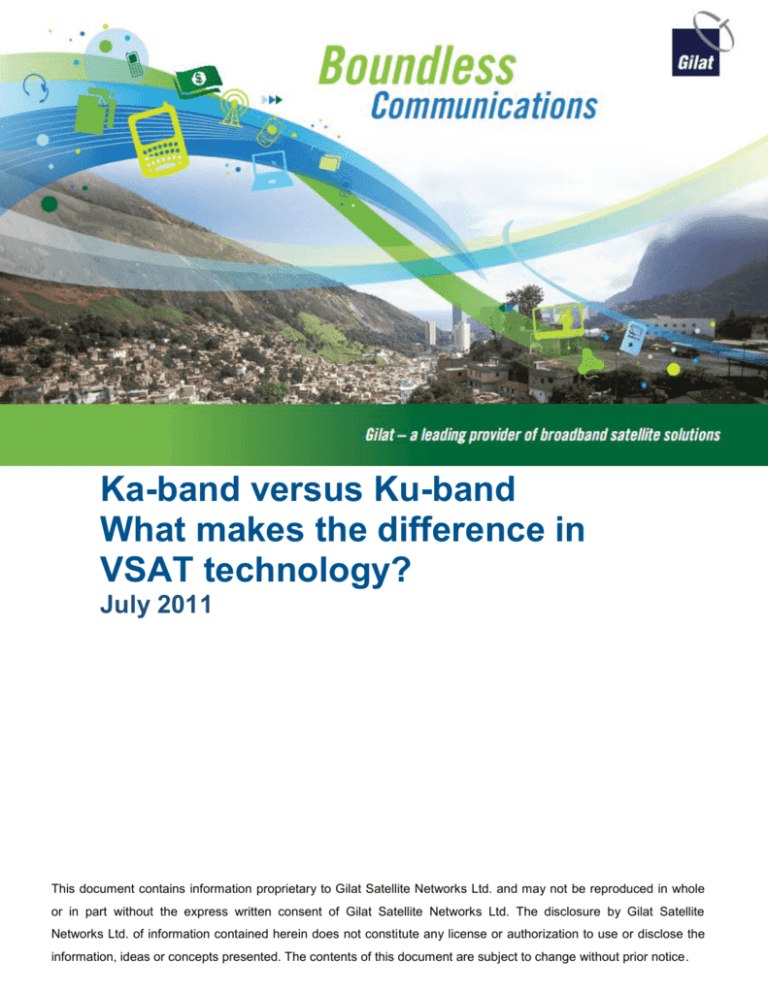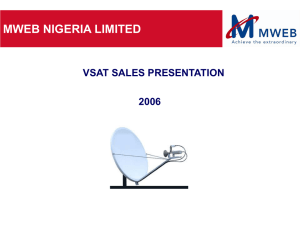Ka-band versus Ku-band What makes the difference in VSAT
advertisement

Ka-band versus Ku-band What makes the difference in VSAT technology? July 2011 This document contains information proprietary to Gilat Satellite Networks Ltd. and may not be reproduced in whole or in part without the express written consent of Gilat Satellite Networks Ltd. The disclosure by Gilat Satellite Networks Ltd. of information contained herein does not constitute any license or authorization to use or disclose the information, ideas or concepts presented. The contents of this document are subject to change without prior notice. Introduction Ka-band has become the band of choice for many satellite operators due to its increasing capacity availability and its applicability for broadband services. New Ka-band satellites are either already in orbit or are being readied for launch. But how does it compare to the traditional Ku-band? This paper discusses the technical advantages and disadvantages? In the past few years we have witnessed a growing amount of Ka-band capacity launched in many regions of the world. Fueled by the growth in Internet-based applications, the demand for satellite capacity has grown similarly to other wireline and wireless communications technologies. The lower Ku-band frequency capacity has filled up in most of the geosynchronous orbital slots. As a result, the growing demand for satellite bandwidth is driving investment in Ka-band as the next choice for launching new satellite capacity. In this paper we will explore the main differences between the Ka and Ku frequency bands, and the corresponding main characteristics of satellite and VSAT technologies. Ka frequencies (~30GHz uplink & ~20GHz downlink) are around twice the frequency used by Ku (~14GHz uplink and ~12GHz downlink). When these high frequencies are transmitted and received in a heavy rain fall area, noticeable signal degradation occurs and is proportional to the amount of rain fall (commonly known as known as “rain fade”). In general, the higher the frequency, the more a signal is susceptible to rain fade. A typical Ku-band rain fade rate is approximately 1dB/sec while the fade rate in Ka-band is significantly higher at around 3-5dB/sec. GILAT SATELLITE NETWORKS PAGE 2 OF 5 Most of the new Ka-band satellites implement spot-beam technology to reuse the frequency band across the desired coverage area. As opposed to wide beams that cover large territories (e.g. all of Europe), spot beams cover much smaller territories (1/50 – 1/100 of the large territory). In addition, because of the wider spectrum available on Ka-band and the need to support many beams, Ka-band satellites typically implement wideband transponders (300MHz – 600MHz), about tenfold compared with the typical 27MHz to 54MHz Ku-band transponders. This type of implementation combined with advanced VSAT transmission technology results in Ka-band satellites with 10-100 times the throughput that is available on the traditional Ku-band satellites. It’s no wonder that the new generation of Ka-band satellites are referred to as High Throughput Satellites or HTS. High-speed Services On the service side, the market trend is to increase the service throughput speeds by at least one order of magnitude compared to existing Ku-band or older generation Ka-band satellites. If standard Ku-band service speeds today are 1-2Mbps, the new services are expected to be 10-20Mbps. These new high-speed services are comparable to 4G, LTE cellular and multi-Mbps services available on standard DSL, cable, and fibre technologies. The new service requirements and high capacity Ka-band satellites introduce new challenges to the VSAT ground segment equipment manufacturers in the following three areas: 1. VSAT CPE terminals which need to be low cost must support very high throughput and provide competitive performance level while mitigating the impact of over 500msec of round trip delay that is a result of pure physics – signals still need to traverse close to 36,000km to and from the satellite. GILAT SATELLITE NETWORKS PAGE 3 OF 5 2. Hub systems need to support multiple beams, many high-throughput forward and return channel carriers, dynamically adapt to changes in signal levels and rain fade conditions, and support multiple Gbps of aggregate throughput. 3. Management systems will need to configure, monitor and control dozens of hub systems, multiple gateways, and 10s to 100s of thousands of VSAT terminals. Gilat has taken initiative with the SkyEdge II VSAT system which was designed and developed to address these new requirements. Here are the main technology attributes related to Ka-band systems: One of the key elements in VSAT performance is acceleration technology. Most VSAT systems have implemented TCP and HTTP acceleration to improve the performance of web-based applications. As demand for Internet-based applications increases, web site implementations become content richer, and because many home users have multiple PCs, tablets and smartphones, these legacy acceleration technologies are no longer sufficient to deliver adequate performance. Gilat’s recently announced CacheMode technology combines a multi-GByte advance cache memory built-in to the VSAT with distributed cache system that takes advantage of the one-to-many multicast transmission inherent to satellite technology to deliver and populate the on-board cache. The ability to deliver and store large amount of web content closer the end user, results in higher performance to webbased applications and lower satellite space segment utilization. Adaptive outbound and inbound transmission mechanisms are mandatory in any VSAT system supporting Ka-band satellites to mitigate the high signal fade rate in Ka-band frequencies. Standard DVB-S2 Adaptive Coding and Modulation (ACM) technology provides partial solution and it is available in most VSAT system only for the forward channel. Gilat VSAT systems also include dynamic Inbound Coding and Modulation technology and a high power 4W Ka-band transceiver together with Automatic Uplink Power Control to provide the highest dynamic range possible. These technologies make the inbound frequency band considerably resilient to changes in weather, other atmospheric conditions and network utilization. The dynamic inbound carriers’ GILAT SATELLITE NETWORKS PAGE 4 OF 5 reconfiguration is implemented automatically 40 times every second enabling the system to guarantee constant network wide throughput at any given time. Wider transponders and higher bit-rate services require advanced modulations to provide maximum carrier throughput. Gilat SkyEdge II system is the first VSAT in the market that has implemented and deployed tens of thousands of node networks using 16APSK modulation in the outbound and 8PSK modulation in the inbound. SkyEdge II has also been successfully deployed with the 32APSK modulation that uses five bits/symbol. System scalability, modularity and management are fundamental elements in Gilat SkyEdge II network architecture. These concepts provide a cost effective system that can support multiple beams with different load levels under a single management systems that can support tens of thousands nodes. Ka-band is not just the next generation frequency band expansion to Ku. It encompasses a new type of satellite architecture, new transmission and bandwidth management to provide higher quality, better performance and faster speed services. These new technologies and services are a major evolution shifting VSAT to an even more competitive position within the spectrum of telecommunication networking platforms. Published in Satellite Evolution Magazine, May/June 2011 For more information, please contact info@gilat.com GILAT SATELLITE NETWORKS PAGE 5 OF 5







